Chapter 1: Why Kyoto is Perfect for Multi-Generational Travel

Kyoto is more than just Japan’s ancient capital—it’s a peaceful, charming city where the past meets the present in a family-friendly atmosphere. For families traveling with children and older adults, Kyoto offers the perfect mix of comfort, accessibility, culture, and fun, making it an ideal destination for multi-generational travel.
🏯 1. A City That Moves at Your Pace
Unlike Tokyo’s hustle and bustle, Kyoto offers a slower, more relaxed rhythm, perfect for grandparents who prefer a gentler pace and children who need rest breaks. Whether you’re strolling through a bamboo forest or sipping tea by a garden, Kyoto allows for meaningful experiences without the rush.
👨👩👧👦 2. Attractions That Appeal to All Ages
Kyoto’s beauty is ageless.
- Children will love the interactive samurai workshops, animal cafés, and hands-on craft experiences like painting fans or making wagashi (Japanese sweets).
- Seniors can enjoy tranquil visits to temples and zen gardens, scenic river cruises, or traditional tea ceremonies.
- Many attractions like Fushimi Inari Shrine, Arashiyama Bamboo Grove, and Kiyomizu-dera Temple are stroller- and wheelchair-accessible with flat paths or shuttle options available.
Kyoto is consistently ranked among Japan’s safest cities—a major plus when traveling with little ones and elderly family members. Clean streets, punctual public transport, and courteous locals ensure that your family will feel comfortable and secure throughout the journey.
🧘 4. Culturally Rich Without Being Overwhelming

For families new to Japan, Kyoto is a wonderful introduction to Japanese culture. You can experience:
- Kimono dressing and photo shoots for all ages
- Temple visits that double as peaceful learning moments
- Local food tastings that accommodate all dietary needs
Most cultural experiences are gentle, quiet, and adaptable, offering engaging activities without physical strain or sensory overload.
♿ 5. Accessible Travel for Seniors and Strollers
Kyoto is making strides in barrier-free tourism, with:
- Elevators and ramps in key temples and museums
- Accessible restrooms at major attractions
- Priority seating and stroller space on public transport
- Taxis that cater to passengers with limited mobility
Many ryokans and hotels also offer rooms with grab bars, walk-in showers, and ground-floor access—perfect for older travelers.
🏨 6. Family- and Senior-Friendly Accommodations
From spacious family hotel rooms to traditional ryokans with tatami floors, Kyoto’s lodging options suit everyone’s comfort level. Some even offer:
- Connecting rooms for large families
- Onsen (hot spring) baths with private or family booking options
- In-room dining for relaxed, stress-free mealtimes
🧸 7. Kyoto Welcomes Families with Open Arms
The city embraces family travel. You’ll find:
- High chairs and kid-friendly menus in many restaurants
- Quiet parks and riverside paths are ideal for downtime
- Cultural centers that welcome both kids and grandparents to join in activities together
🌟 In Summary: Timeless, Gentle & Memorable
Kyoto is where three generations can enjoy shared experiences, discover Japanese traditions, and create lifelong memories—all at a pace that suits everyone. With kid-friendly fun, senior-sensitive comfort, and a warm, welcoming atmosphere, Kyoto truly is a destination that connects hearts across generations.
Chapter 2: Best Times to Visit Kyoto with Family or Seniors
Planning a trip to Kyoto is all about timing, especially when you’re traveling with children and older adults. Whether you’re hoping to catch cherry blossoms, avoid crowds, or enjoy a comfortable climate, choosing the right time to visit can make all the difference.
Let’s explore the best seasons for multi-generational travel to Kyoto and what to expect in each.
🌸 1. Spring (March to May): Cherry Blossoms & Perfect Weather
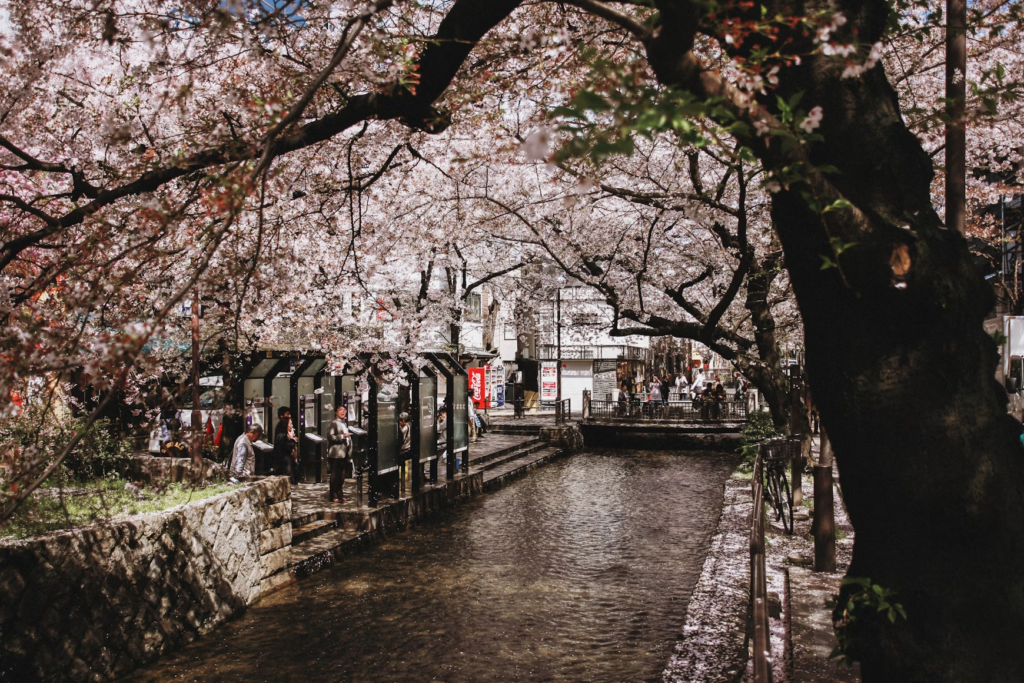
Why it’s ideal for families and seniors:
- Comfortable temperatures (10°C to 22°C) make walking easy.
- The city comes alive with cherry blossoms, especially in parks like Maruyama Park, Philosopher’s Path, and Arashiyama.
- Family-friendly hanami (flower viewing) picnics are popular and relaxing for all ages.
Things to keep in mind:
- It’s a peak season, so book accommodations early.
- Some areas may be crowded—plan early morning or weekday visits.
🍁 2. Autumn (Mid-October to Early December): Colorful Leaves & Mild Days
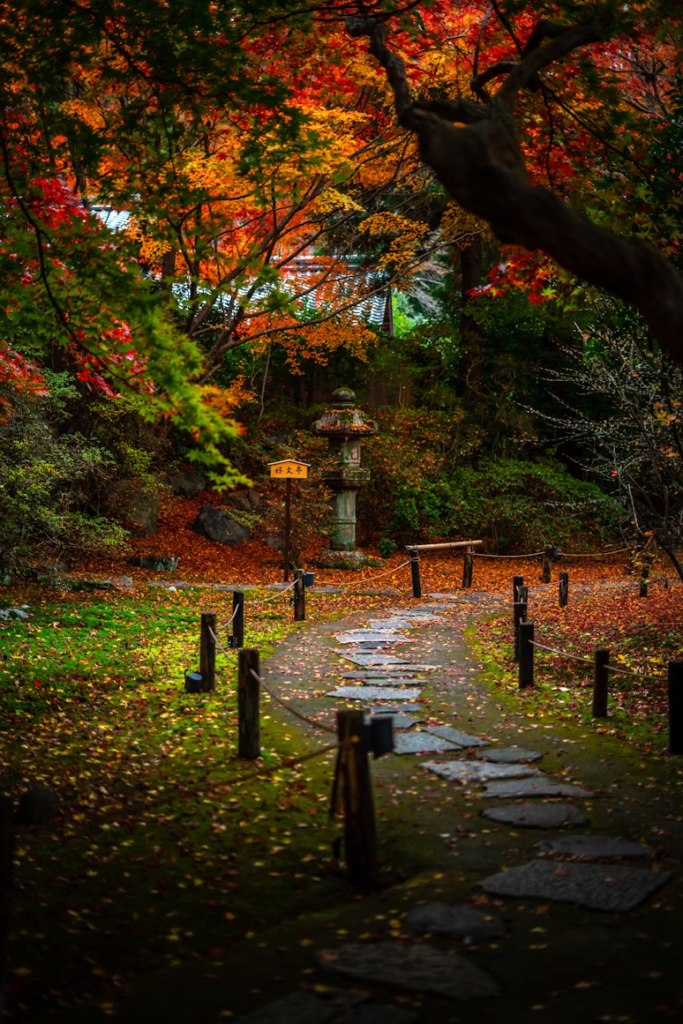
Why it’s ideal:
- The weather is mild and dry (10°C to 20°C)—great for older adults and young kids.
- Stunning autumn foliage transforms temples like Eikando, Tofuku-ji, and Kiyomizu-dera into breathtaking scenes.
- Fewer insects and lower humidity than summer.
Family tip:
Plan nature walks, gentle hikes, and photo stops. The crisp air and colorful scenery create the perfect family bonding moments.
🌞 3. Summer (June to August): Festivals & Energy (But Be Prepared!)
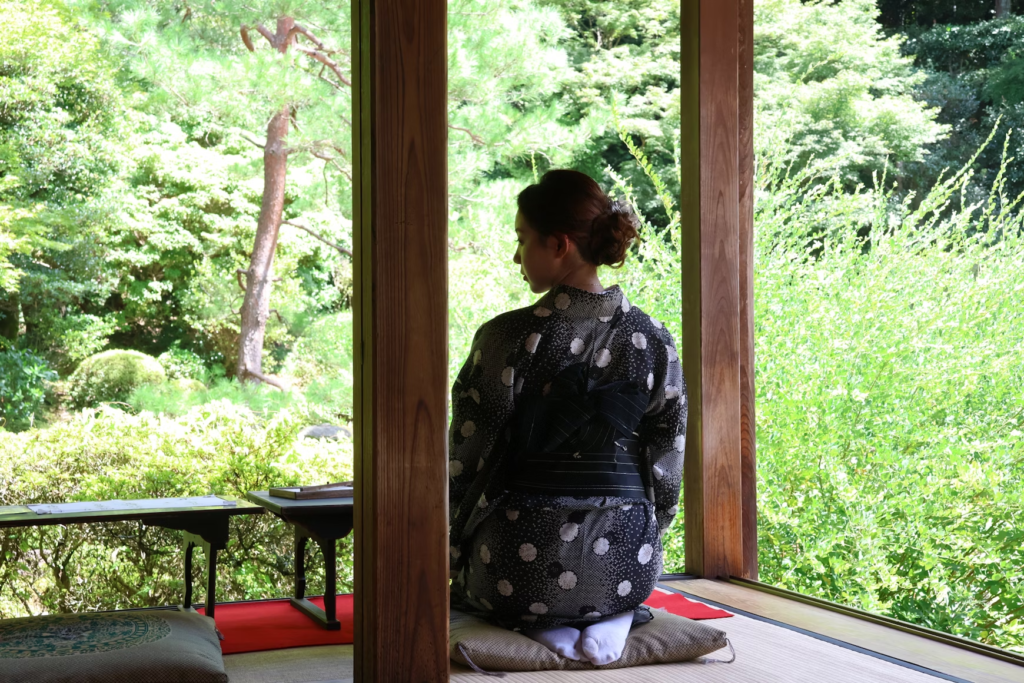
Is it right for your family?
- Kyoto hosts famous festivals like Gion Matsuri (July), which can be exciting for kids.
- However, high humidity and temperatures (up to 35°C) can be difficult for seniors and younger children.
Suggestions if traveling in summer:
- Stay in accommodations with air-conditioning.
- Take breaks indoors (museums, aquariums, cafés).
- Visit early in the morning or late afternoon.
- Carry sun hats, fans, cooling wipes, and water bottles at all times.
❄️ 4. Winter (December to February): Quiet, Serene & Budget-Friendly
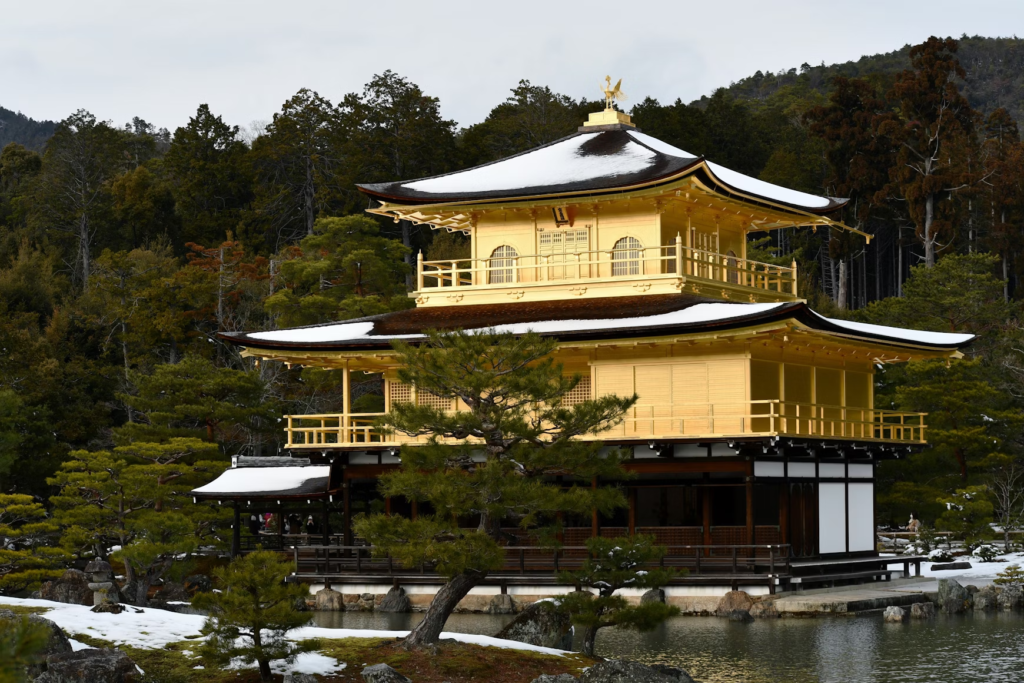
Why you might consider it:
- Low crowds make sightseeing peaceful, perfect for seniors.
- Beautiful snow-dusted temples and quiet shrines create a magical atmosphere.
- Accommodations are more affordable, and indoor cultural activities are plentiful.
What to plan for:
- Cold temperatures (0°C to 10°C), so pack warm layers.
- Choose attractions with indoor experiences, like tea ceremonies, cooking classes, or museums.
📅 5. Avoiding Crowds & School Holidays
If you’re looking for a more relaxed, stress-free experience:
- Avoid Japan’s Golden Week (late April–early May)
- Skip Obon Holiday (mid-August) and New Year’s period (late Dec–early Jan)
- Try weekdays and early mornings at popular attractions
These strategies will help keep your trip peaceful and enjoyable for both grandparents and young kids.
🧭 6. Best Months Summary Table
| Month | Weather | Highlights | Travel Tip |
|---|---|---|---|
| March | Cool, blooming | Early blossoms, low crowds | Dress in layers |
| April | Mild, dry | Peak cherry blossom season | Book ahead |
| May | Warm, green | Ideal weather, fresh scenery | Great for park days |
| June–July | Humid, rainy | Hydrangeas, Gion Festival | Carry rain gear & plan indoor stops |
| August | Hot | Fireworks, summer festivals | Stay hydrated & limit midday outings |
| September | Cooling down | Start of foliage | Excellent for temple walks |
| October | Crisp, clear | Autumn colors begin | Ideal time for all ages |
| November | Peak autumn | Full foliage, cool temperatures | Book temples with gardens & seating areas |
| December | Cool, festive | Quiet shrines, winter lights | Bundle up and enjoy serenity |
| January | Cold | New Year traditions, snow scenes | Try indoor cultural experiences |
| February | Still cold | Plum blossoms, fewer tourists | Peaceful travel & lower hotel prices |
🎒 In Summary: Travel Smart for Comfort and Joy
For multi-generational travel, spring and autumn are the clear winners, offering comfortable weather, beautiful scenery, and a good balance of outdoor and indoor experiences. However, with the right planning, any season in Kyoto can be a memorable adventure for kids and seniors alike.
Chapter 3: Getting to Kyoto – Smooth Arrivals for All Travelers
Getting to Kyoto is easier than you might think. Whether you’re flying in from overseas or arriving from other parts of Japan, there are multiple convenient, comfortable ways to reach this historic city. With proper planning, even families with young children or seniors with limited mobility can enjoy a stress-free arrival.
✈️ 1. Flying into Japan: Which Airport is Best?

While Kyoto doesn’t have its own airport, it’s easily accessible from two major airports:
✅ Kansai International Airport (KIX) – Best for Direct Access
- Located in Osaka, about 75–90 minutes from Kyoto
- Ideal for international flights and first-time visitors
- Offers limousine buses, JR trains, and private transfer options
✅ Itami Airport (ITM) – Closer but Domestic Only
- Serves domestic flights from Tokyo, Hokkaido, and other cities
- About 50 minutes to Kyoto by limousine bus or taxi
- Good for families flying internally within Japan
🚄 2. From Major Cities to Kyoto by Train
The Shinkansen (bullet train) is the fastest and most comfortable way to reach Kyoto from other parts of Japan:
🧳 From Tokyo
- Tokaido Shinkansen (Nozomi or Hikari)
- Time: Around 2 hours 20 minutes
- Tip: Reserve seats for groups and choose rows near restrooms for children or seniors
🧳 From Osaka
- Regular JR trains or Shinkansen from Shin-Osaka Station
- Time: Only 15–30 minutes
- Affordable and perfect for short transfers
🧳 From Hiroshima
- Shinkansen direct to Kyoto
- Time: Around 1 hour 40 minutes
- Great for combining with a western Japan itinerary
🛤️ 3. Understanding the JR Pass (and Other Passes)
For families and retirees traveling across multiple cities, the Japan Rail Pass (JR Pass) offers excellent value:
- Valid on most Shinkansen (excluding Nozomi)
- Children under age 6 ride free without a reserved seat
- Discounts available for children aged 6–11
- Perfect for multi-city trips (Tokyo–Kyoto–Osaka–Hiroshima)
For Kansai-only trips, consider:
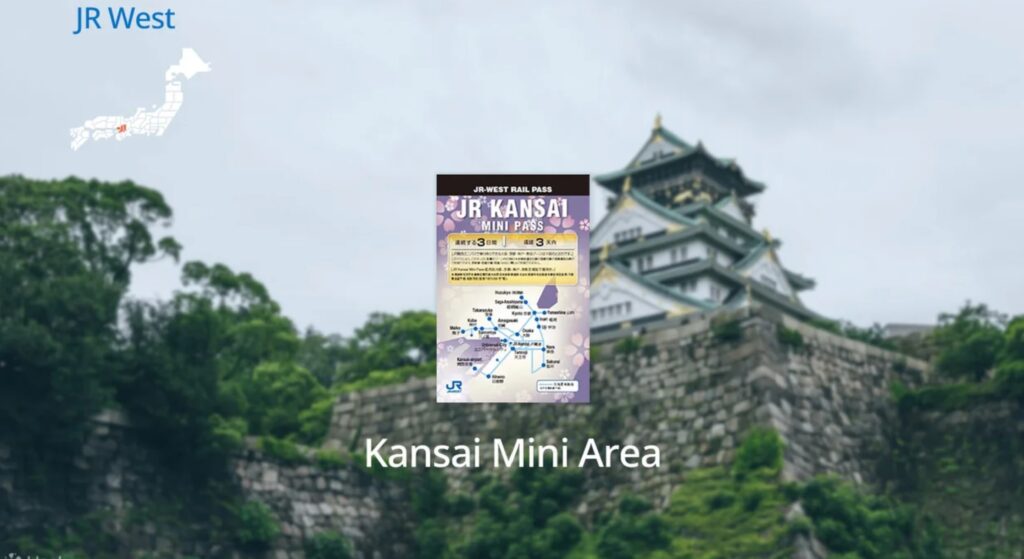
- Kansai Area Pass
- ICOCA + Haruka package (includes airport express + prepaid card)
🚕 4. Door-to-Door Options for Maximum Comfort
For travelers with mobility concerns or families carrying multiple bags, private transfers and airport taxis can be well worth the cost.
🚐 Private Airport Transfers
- Door-to-door drop-off at your Kyoto hotel or ryokan
- Ideal for seniors, families with strollers, or first-time travelers
- Book online in advance for peace of mind
🚌 Limousine Bus to Kyoto Station
- Direct, affordable, and comfortable
- Spacious seating and room for luggage
- Most buses have toilets onboard
🎒 5. Luggage Delivery Services – Travel Hands-Free!
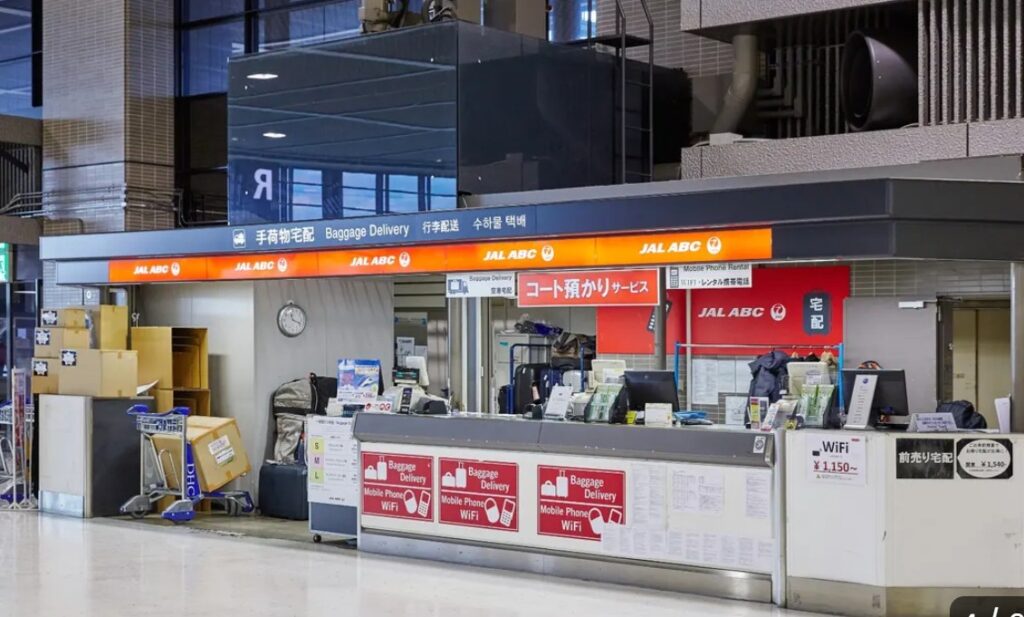
Japan offers convenient same-day or overnight luggage forwarding services (called “takuhaibin”), available at airports and hotels.

- Send bulky bags from the airport straight to your Kyoto hotel
- Great for seniors who want to travel light
- Recommended providers: Yamato Transport (Kuroneko), JAL ABC
🗺️ 6. Arriving at Kyoto Station – What to Expect
Kyoto Station is the city’s main gateway and transportation hub.
- Well-signed in English and wheelchair/stroller accessible
- Elevators, escalators, and ramps are widely available
- On-site facilities: restrooms, coin lockers, food courts, ATMs, and visitor information desks
Tip for Families & Seniors: Use the Central Gate to access most transport and taxi services quickly.
🧭 7. Final Tips for a Smooth Arrival
- Pre-book train tickets, reserve seats online or at stations
- Keep your passports and JR Pass vouchers handy for exchange
- Bring snacks, water, and entertainment for little ones on long rides
- Download Google Maps or NAVITIME Japan Travel for easy navigation
🧳 In Summary: Start Your Kyoto Journey with Ease
Kyoto is well-connected and thoughtfully designed for visitors of all ages. Whether you’re flying in, taking a train, or arriving by private car, your journey can be just as enjoyable as the destination. With a little planning, you’ll ensure a comfortable, calm arrival, setting the tone for a beautiful stay in Kyoto with your loved ones.
Chapter 4: Getting Around Kyoto with Ease
Navigating Kyoto is simpler than many first-time visitors expect. The city is compact, well-organized, and designed with convenience in mind, making it an ideal destination for families and seniors alike. From user-friendly public transport to stroller- and wheelchair-accessible attractions, here’s how to explore Kyoto smoothly and stress-free.
🚍 1. Public Transportation Overview: Easy, Safe, Reliable

Kyoto’s public transport system includes:
- City buses – extensive coverage of tourist spots
- Subways – fast and frequent for longer distances
- JR lines and private railways connect Kyoto to nearby cities like Osaka, Nara, and Uji
- Taxis – plentiful, clean, and comfortable, especially for groups
For Multi-Generational Travelers:
Public transport is safe and punctual, but not all stations or buses are equally accessible. Choose routes that avoid unnecessary transfers and long walks.
🚌 2. Using Kyoto City Buses
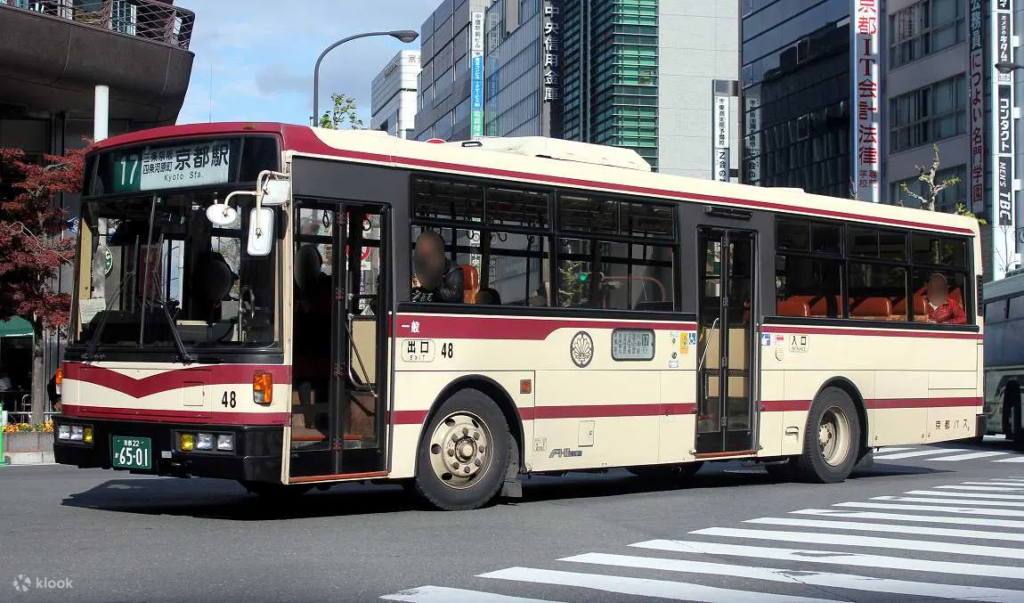
Pros:
- Direct access to major temples, shrines, and landmarks
- Affordable and frequent
Cons:
- It can get crowded during peak hours and seasons
- Slower due to traffic
Tips for Families & Seniors:
- Board from the rear, exit from the front, and pay when you get off
- Use IC cards or the Kyoto Bus One-Day Pass for unlimited rides
- Priority seats available—just ask kindly if they’re occupied
🚇 3. Riding the Kyoto Subway

Kyoto’s two subway lines (Karasuma Line and Tozai Line) are:
- Clean, punctual, and air-conditioned
- Less crowded than buses
- Elevator-equipped stations make them ideal for strollers or mobility aids
Popular Stops:
- Karasuma Oike Station – great transfer point
- Kyoto Station – a major transport hub
- Keage Station – walking distance to Nanzen-ji and the Philosopher’s Path
🚆 4. JR Lines & Private Railways for Nearby Day Trips
Kyoto is connected by train to many family- and senior-friendly destinations:
- JR Nara Line to Nara (friendly deer park and historical sites)
- Sagano Line to Arashiyama (bamboo grove, river, monkey park)
- Keihan and Hankyu Lines to Osaka or Uji (matcha town)
Tip: If you have a JR Pass, use JR trains where possible to save money.
Klook.com💳 5. IC Cards & Day Passes: Making Travel Easy
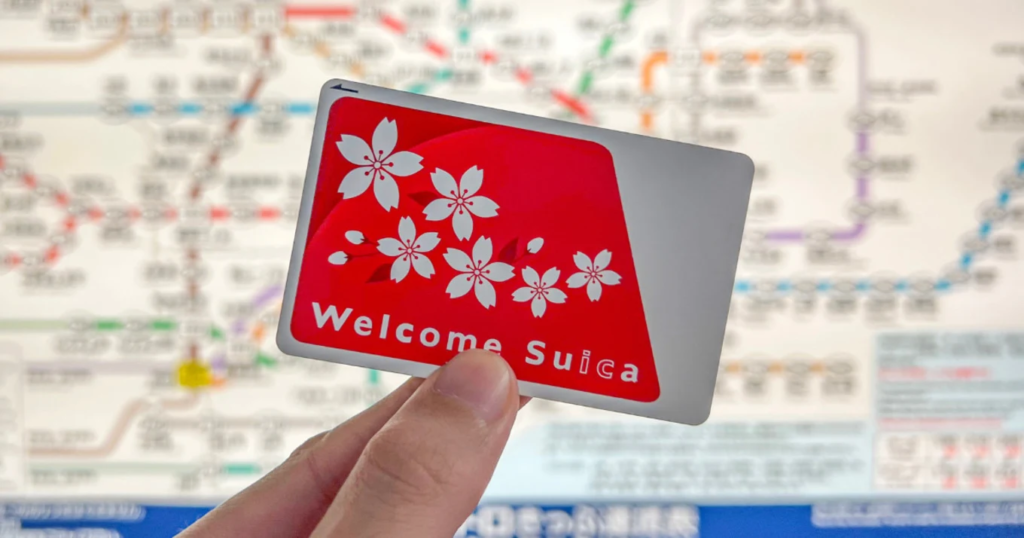
✅ IC Cards (like ICOCA, Suica, Pasmo):
- Prepaid cards are usable on buses, trains, subways, and even vending machines
- Just tap to pay—no ticket machines needed
- Rechargeable at stations and convenience stores
✅ Kyoto Bus & Subway Passes:
- 1-Day Bus Pass (500 yen) – Unlimited rides on Kyoto city buses
- Kyoto Subway & Bus 1/2-Day Passes – Combine both modes of transport
- Great for tourists visiting multiple sites in one day
🚖 6. Taking Taxis in Kyoto: Comfort for Families & Seniors
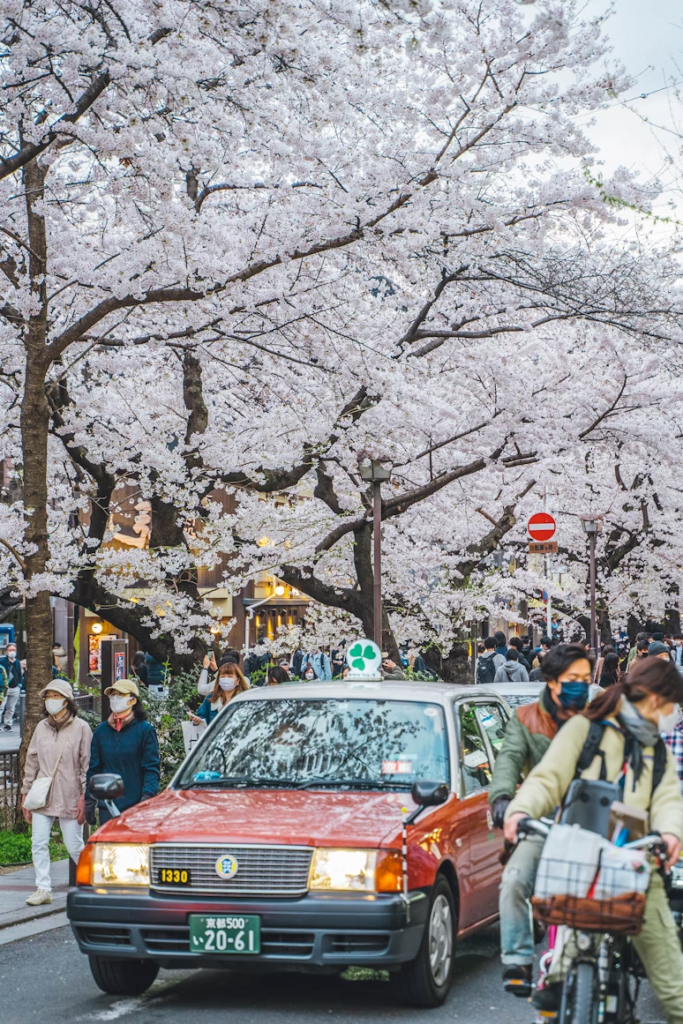
Taxis in Kyoto are:
- Clean, reliable, and driven by courteous professionals
- A practical choice for short distances, bad weather, or tired feet
- Reasonably priced for groups (fits 4–5 people)
Tip for Retirees:
Some taxis are specially marked as “barrier-free”, with wider doors and wheelchair support.
🚲 7. Renting Bicycles or Walking Around
🚶♀️ Walking:
- Many popular districts like Gion, Higashiyama, and Arashiyama are walkable
- Paved paths and scenic strolls are ideal for slow-paced exploration
- Rest spots and vending machines are plentiful
🚲 Bike Rentals:
- Available citywide, with child seats or electric options
- Only recommended for older kids and mobile adults
- Avoid during high traffic times or with elderly travelers unfamiliar with Japanese roads
♿ 8. Accessibility in Kyoto: Wheelchair & Stroller-Friendly Travel
Kyoto is increasingly barrier-free, especially in popular spots:
- Temples with ramps or elevator access: Kiyomizu-dera, Ryoan-ji, Nijo Castle
- Major stations with elevators and accessible toilets
- Many hotels offer wheelchair-accessible rooms
Apps like “Japan Travel by NAVITIME” and “Wheelchair Walker” help locate accessible routes and facilities.
👨👩👧👦 9. Tips for Families with Young Children
- Many buses and trains allow folded strollers onboard
- Some train stations offer nursing rooms or diaper-changing facilities
- Bring small toys, snacks, or tablets for longer rides
- Travel during mid-morning or early afternoon to avoid rush hour
🧓 10. Tips for Senior Travelers
- Avoid steep stairways by checking station maps for elevators/escalators
- Plan for plenty of rest stops in your daily itinerary
- Consider booking a guided tour with transport included for maximum ease
Getting around Kyoto is wonderfully manageable, even with little ones or older adults in tow. With smart use of transport passes, comfortable walking routes, and plenty of accessibility support, you’ll be free to explore at your family’s pace, without the stress.
Chapter 5: Where to Stay – Family & Senior-Friendly Accommodations
Choosing the right place to stay can make or break your Kyoto experience, especially when you’re traveling with young children or older adults. Fortunately, Kyoto offers a wide range of accommodations that combine comfort, convenience, and cultural charm, catering to the needs of multi-generational travelers.
From spacious family suites to barrier-free ryokans, this guide will help you find the perfect home base for your Kyoto adventure.
🏨 1. Best Areas to Stay in Kyoto

Each neighborhood has its own vibe—some are ideal for temple-hopping, others for food, shopping, or peace and quiet. Here are the best options for families and seniors:
📍 Kyoto Station Area – Most Convenient
- Easy access to public transport, shops, and restaurants
- Ideal for first-time visitors or those with limited mobility
- Great for early morning tours or quick day trips to Osaka or Nara
📍 Gion & Higashiyama – Historic Charm
- Close to famous attractions like Kiyomizu-dera, Yasaka Shrine, and Maruyama Park
- Ideal for slow, scenic strolls through traditional Kyoto
- Boutique hotels and ryokans abound
📍 Arashiyama – Nature-Filled Retreat
- Quiet, family-friendly atmosphere near the Bamboo Grove
- Great for longer stays and relaxing away from the city center
- Lovely for seniors seeking tranquility
📍 Downtown (Kawaramachi, Nishiki Market area) – Food & Shopping
- Lively but accessible, with lots of restaurants and shopping arcades
- A great balance of city energy and cultural experiences
🛌 2. Types of Accommodations for Multi-Generational Travelers
🏨 Family Hotels with Western Comforts
- Spacious rooms, elevators, and private bathrooms
- High chairs, cribs, and extra bedding are often available
- Brands like Hotel Granvia Kyoto, Mitsui Garden Hotel, and Citadines are family favorites
🏠 Japanese Ryokans (Inns)
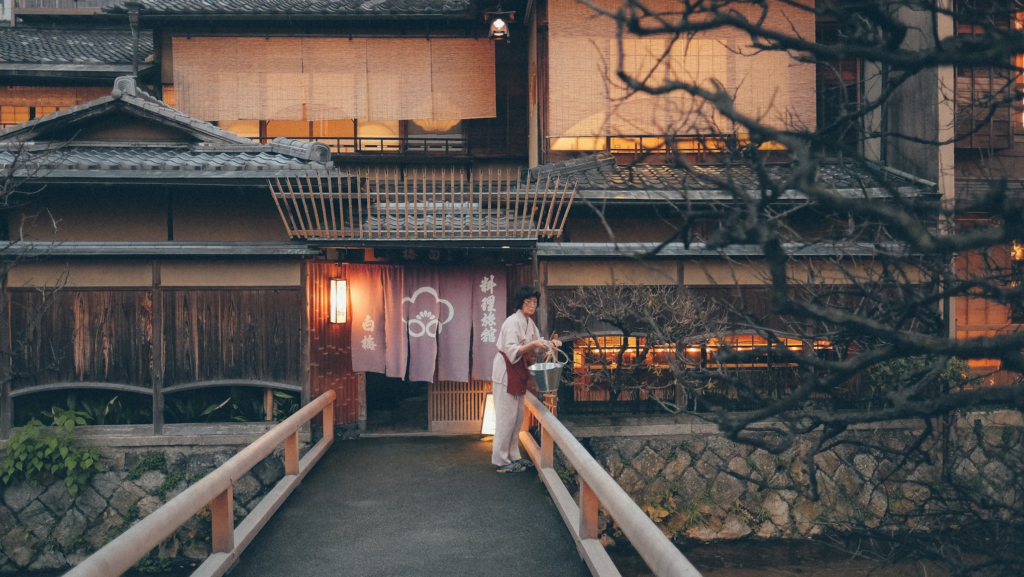
- Sleep on futons in tatami-mat rooms—fun for kids, nostalgic for seniors
- Many offer private onsen baths, ideal for grandparents
- Look for ryokans with modern amenities and ground-floor rooms
Tip: Choose ryokans labeled as “barrier-free” or offering Western-style beds for elderly guests.
🏡 Vacation Rentals & Machiya Townhouses
- Great for large families who want a private, homelike space
- Kitchens, laundry, and multiple bedrooms make longer stays easier
- Traditional Kyoto feel, but check for stairs if traveling with elders
♿ 3. Accessibility Considerations
Kyoto is increasingly inclusive, and many accommodations now offer:
- Wheelchair-accessible entrances and bathrooms
- Elevators instead of steep staircases
- Barrier-free rooms with walk-in showers and grab bars
- Wide doorways for strollers or mobility devices
Tip: Always contact your hotel directly to confirm accessibility details in advance.
👶 4. What to Look For: Family-Friendly Amenities
- Cribs and child beds upon request
- Baby-proof rooms with corner guards and outlet covers
- Child-friendly buffets or set meals
- Laundry facilities for longer stays
- Quiet rooms away from nightlife zones
Hotel chains to consider:
- Dormy Inn Premium Kyoto (family-style hot spring hotel)
- Sakura Terrace (offers both Western and Japanese room options)
- Kyoto Yura Hotel MGallery (elegant and senior-friendly)
🧓 5. What to Look For: Senior Comfort Features
- Rooms on lower floors or elevator access
- Western-style beds instead of futons (or futons on raised platforms)
- Shuttle service or proximity to bus/subway stops
- Onsen baths with support rails or private soaking tubs
- Flexible check-in/check-out times
Tip: Look for hotels with on-site restaurants, so seniors don’t have to go far for meals.
🛏️ 6. Sample Stays for Different Travel Styles
| Type of Traveler | Recommended Stay |
|---|---|
| Large Family Group | Machiya townhouse with kitchen and tatami rooms |
| Seniors Traveling Alone | Barrier-free business hotel near Kyoto Station |
| Parents with Young Kids | Hotel with crib rental and a family-size room downtown |
| 3-Generation Group | Modern ryokan with Western beds, onsen, and elevator access |
🗝️ 7. Booking Tips & Advice
- Use filters for “family rooms,” “barrier-free,” or “child-friendly” on booking platforms like Booking.com, Agoda, or Rakuten Travel
- Book early for peak seasons (spring and autumn)
- Consider direct booking with the hotel for better rates or special family plans
- Confirm room layouts and amenities through email if needed—some Japanese rooms may be smaller than expected
🌟 In Summary: Comfort for All Generations
Whether you’re looking for a spacious hotel suite near the station or a quiet ryokan in the hills of Arashiyama, Kyoto has a perfect place for your family. Prioritize location, accessibility, and amenities, and you’ll enjoy a restful, memorable stay that suits both kids and seniors.
Chapter 6: Top Attractions for All Ages
Kyoto is filled with magical places that appeal to both wide-eyed children and culture-loving seniors. From shimmering temples to scenic walks, the city offers countless ways to connect across generations. In this chapter, we spotlight Kyoto’s must-visit attractions—chosen for their cultural value, accessibility, family friendliness, and overall comfort.
🏯 1. Fushimi Inari Taisha – Thousand Torii Gates
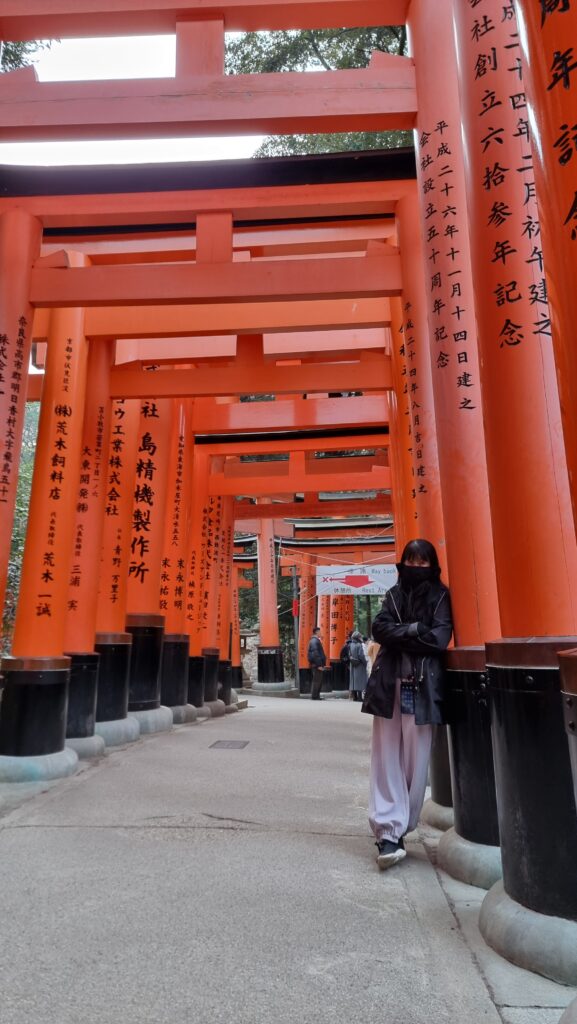
- Why families love it: Kids enjoy walking through the tunnel of bright red torii gates—it feels like a scene from a storybook.
- Why it suits seniors: The first section is flat and shaded, and seniors can enjoy the shrine’s peaceful lower area without climbing.
- Family Tip: Go early in the morning to avoid crowds and heat. Bring snacks and take breaks at rest stops along the way.
🌿 2. Arashiyama Bamboo Grove & River Area
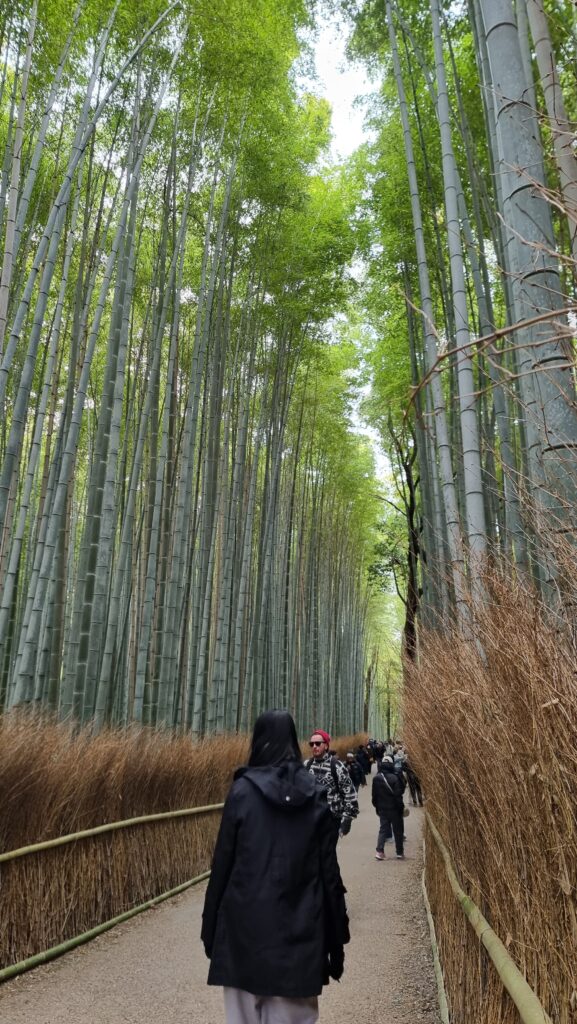
- Why families love it: Giant bamboo stalks, rickshaw rides, and monkey watching at Iwatayama Park (for older kids).
- Why it suits seniors: The riverside and bamboo paths are mostly flat and serene.
- Nearby attractions: Tenryu-ji Temple (UNESCO site), scenic Togetsukyo Bridge, and a small boat ride on the Hozugawa River.
- Accessibility: Paved walking paths, toilets, and benches are available.
🏛️ 3. Kinkaku-ji (Golden Pavilion) – Kyoto’s Most Iconic Temple
- Why families love it: Its sparkling golden reflection on the pond is stunning and easy for even toddlers to appreciate.
- Why it suits seniors: It’s a short, leisurely walk with benches and viewing areas along the way.
- Accessibility Tip: While some paths have stairs, most of the garden loop is stroller- and wheelchair-friendly.
🐠 4. Kyoto Aquarium & Kyoto Railway Museum
- Great for rainy days or hot afternoons
- Kyoto Aquarium: Interactive exhibits, penguins, and aquatic shows make it a hit with children.
- Kyoto Railway Museum: Large open spaces, train simulators, and classic locomotives excite both kids and nostalgic adults.
- Why it suits seniors: Indoor seating areas, elevators, and shaded environments
🌸 5. Maruyama Park & Yasaka Shrine
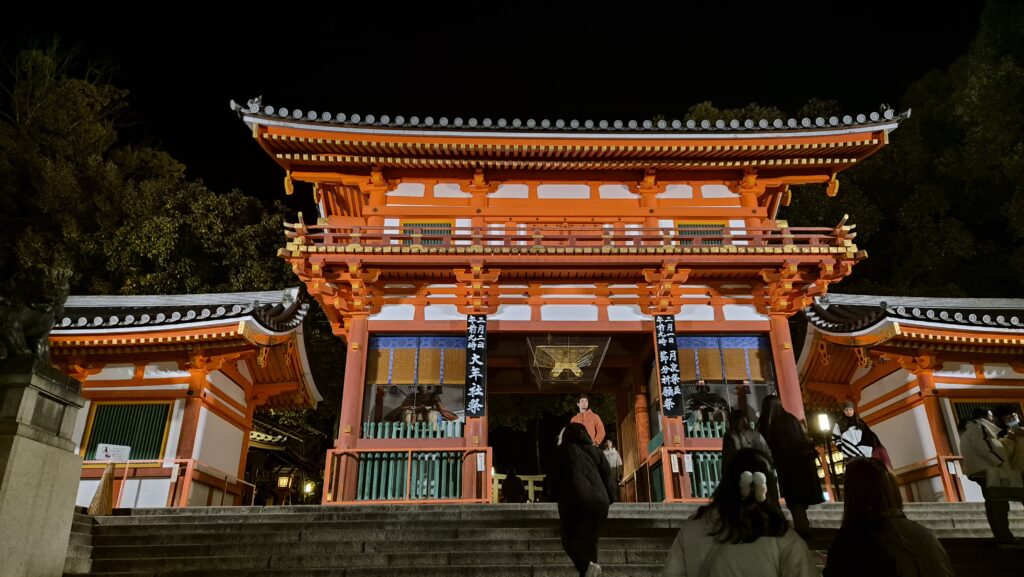
- Why families love it: Maruyama Park is perfect for picnics, duck watching, and seasonal flower viewing.
- Why it suits seniors: Wide, paved paths with benches under cherry trees offer the perfect rest-and-watch spots.
- Nearby bonus: The Gion District is within walking distance for those interested in geisha culture.
🧘 6. Kiyomizu-dera Temple – Panoramic City Views
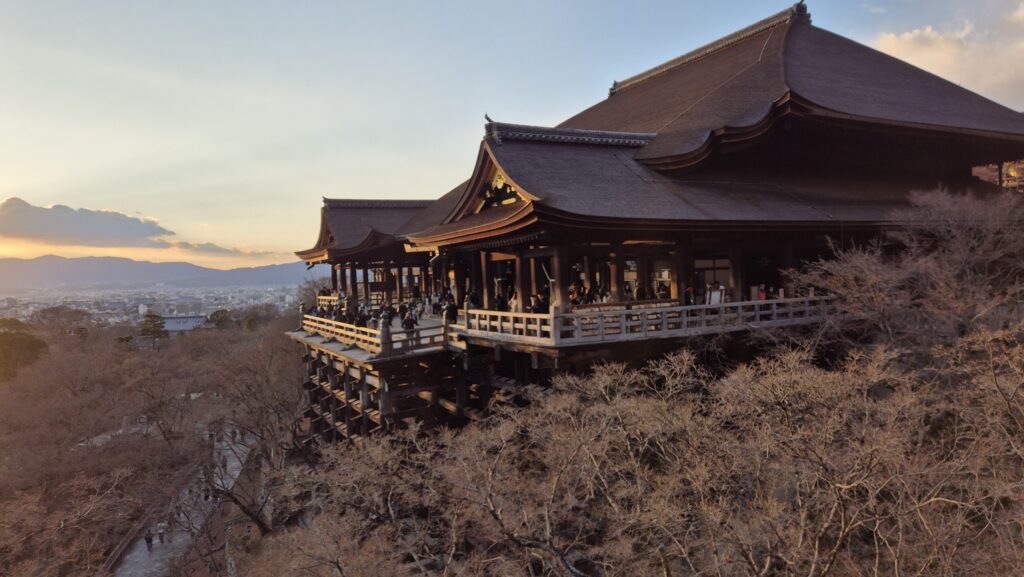
- Why families love it: Kids enjoy peering over the wooden terrace and exploring the old streets nearby (Sannenzaka and Ninenzaka).
- Why it suits seniors: Though there’s a mild uphill climb, there are ramps, rest spots, and a tram nearby for easier access.
- Tip: Don’t miss the Otowa Waterfall for a fun (and symbolic) sip of wisdom, longevity, or love.
🛶 7. Philosopher’s Path – A Peaceful Walk for All Ages
- A gentle, scenic walkway lined with cherry trees, stone bridges, and quiet cafes
- Ideal for strolls, nature watching, and soft conversations
- Perfect for young kids who need a calm environment, and seniors who enjoy a thoughtful walk without steps
☕ 8. Nishiki Market – Kyoto’s Kitchen Alley
- Why families love it: Kids can sample mochi, ice cream, grilled seafood, and fruit sticks.
- Why it suits seniors: Covered and mostly flat, with many places to stop for tea or small bites.
- Tip: Go before 11 am to beat the crowd and enjoy a quieter food experience.
👘 9. Gion District & Traditional Cultural Experiences
- Stroll through old wooden teahouses and spot a geiko or maiko in full dress
- Enjoy a short tea ceremony, calligraphy lesson, or kimono dressing session that can be tailored for all ages
- Family tip: Book private or small group sessions to ensure comfort and attention for everyone
🚞 10. Sagano Romantic Train (Torokko Train)
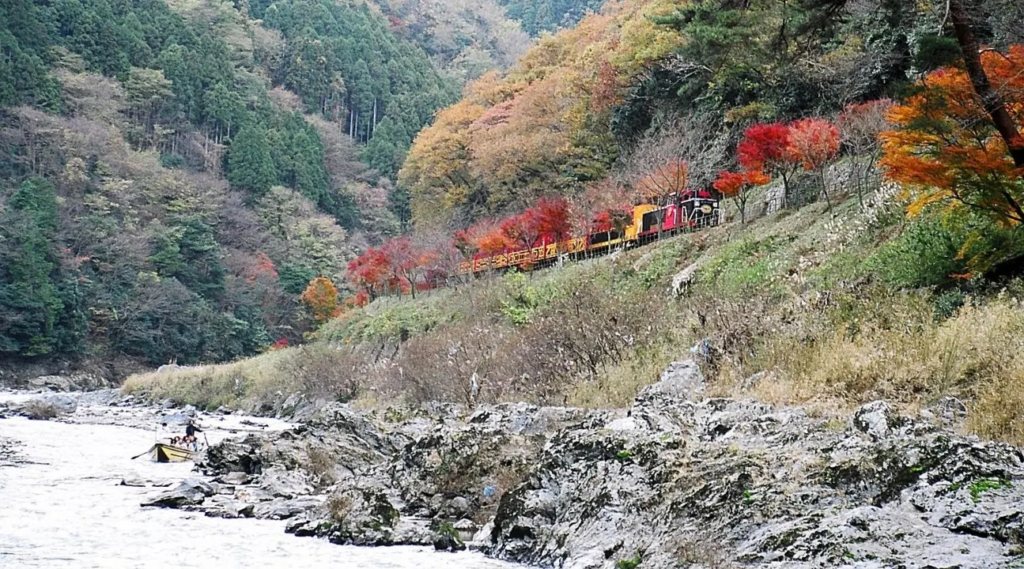
- A slow-moving scenic train ride through a gorge, especially beautiful in spring and autumn
- Great for all ages—children love the open carriages, while seniors enjoy the relaxing views
- Starts from Arashiyama and pairs well with a bamboo grove visit
👨👩👧👦 Bonus: Family and Senior-Friendly Parks & Gardens
| Place | Why It’s Great |
|---|---|
| Kyoto Botanical Gardens | Wide paths, seasonal blooms, and quiet seating areas |
| Umekoji Park | Next to the aquarium, picnic spots and open space for children |
| Heian Shrine Garden | Beautiful, serene, and flat—ideal for gentle strolls or feeding koi fish |
| Kyoto Gyoen National Garden | Historical grounds with open walking paths, ideal for wheelchairs and strollers |
Kyoto’s top attractions are more than beautiful—they’re thoughtfully accessible, engaging across generations, and full of opportunities to learn, relax, and bond. Whether you’re admiring a golden temple, wandering through bamboo, or sampling sweets at a market, you’ll find that Kyoto is truly a destination everyone can enjoy together.
Chapter 7: Kid-Friendly Fun & Educational Experiences
Traveling with children in Kyoto doesn’t mean sacrificing meaningful experiences—quite the opposite! Kyoto is filled with hands-on cultural activities, charming animal encounters, and gentle adventures that spark curiosity and bring Japanese traditions to life.
Whether you’re a parent or a grandparent, these activities are perfect for spending quality time together while helping kids discover the wonder of Kyoto.
🎨 1. Kyoto Handicraft Center
Creative workshops the whole family can enjoy
- Kids can make traditional fans, woodblock prints, kokeshi dolls, or paint miniature samurai helmets.
- All materials are provided and staff offer easy instructions—even in English.
- Why it’s great: Calm indoor space, suitable for all weather; benches and elevators available for seniors.
🧁 2. Wagashi (Japanese Sweets) Making Class
- Families can try their hand at making beautiful, seasonal Japanese sweets from natural ingredients.
- Great for fine motor skills and artistic expression.
- Many classes are held in accessible studios with seating options for older adults.
- Bonus: Eat your own creations with matcha tea afterward!
🎭 3. Samurai & Ninja Experience Museum Kyoto
Learn and play with Japan’s legendary warriors
- Kids can dress up in ninja or samurai costumes, handle safe practice swords, and enjoy interactive exhibits.
- Seniors can enjoy watching or learning about samurai armor and the Bushido code at a comfortable pace.
- Family tip: Take a commemorative photo in full costume—it’s a favorite for all ages!
🐵 4. Iwatayama Monkey Park (For active families with older kids)
- Located in Arashiyama, this park offers a gentle hike to see wild macaques roaming freely.
- You can feed them from a safe, enclosed hut—super exciting for children.
- Note: Not recommended for seniors with mobility issues, as there’s a 20–30 minute uphill walk.
🚂 5. Kyoto Railway Museum
All aboard for fun and learning
- One of Japan’s best train museums with real locomotives, driving simulators, and interactive exhibits.
- Kids love exploring the bullet trains, while grandparents enjoy nostalgic steam engines.
- Indoor, barrier-free facility with stroller and wheelchair access.
🐧 6. Kyoto Aquarium
Marine fun in the heart of the city
- See dolphins, jellyfish, seals, and penguins up close.
- The dolphin show is especially popular with kids and features accessible seating.
- Plenty of quiet resting spots and indoor cafés make it stress-free for families with toddlers and seniors alike.
🐾 7. Animal Cafés & Owl Forests
Cuddle time with Kyoto’s cutest residents
- Visit places where you can safely interact with hedgehogs, owls, cats, or even micro pigs.
- Kids love the novelty, and seniors enjoy the quiet, cozy café environments.
- Located mainly around the Gion and Kawaramachi districts.
🎐 8. Kimono Dress-Up & Family Photo Sessions

- Choose a traditional kimono or yukata and take family portraits in beautiful settings like Gion or Maruyama Park.
- Some shops offer children’s sizes and assistance for seniors with limited mobility.
- Bonus: Combine with a tea ceremony for a full cultural experience.
🏮 9. Evening Cultural Shows at Gion Corner
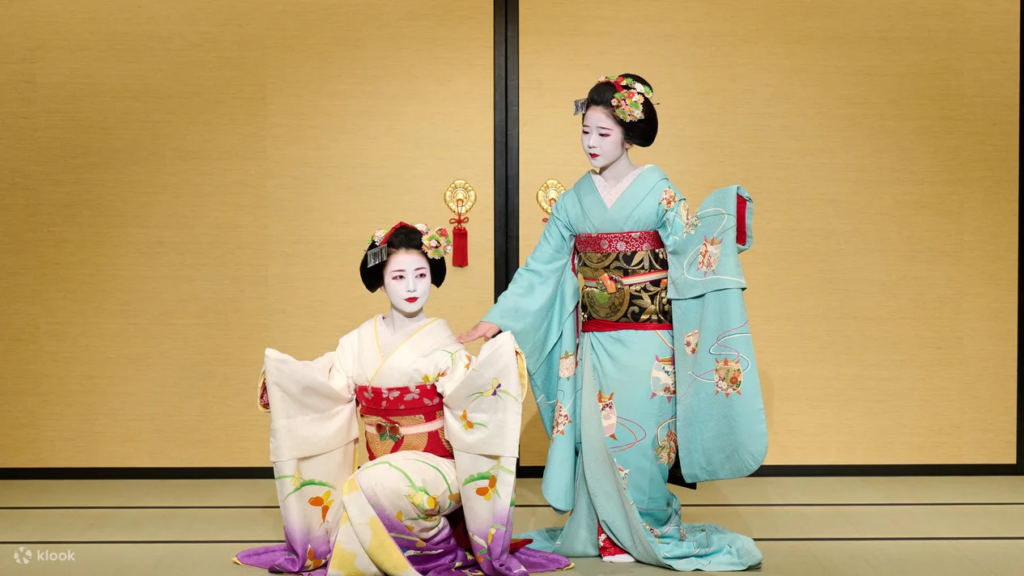
- Short performances that introduce Kyoto’s traditional arts in an easy-to-understand format.
- Includes tea ceremony, ikebana (flower arranging), koto music, and Kyomai dance by maiko (apprentice geisha).
- Quiet indoor setting, great for all ages and attention spans.
🧘 10. Zen Garden Visits & Rock Raking Activities
- Several temples, such as Ryoan-ji and Shunko-in, offer interactive moments where kids can help “rake” the gravel as monks do.
- It’s both calming and engaging—like meditative play.
- Great for seniors who enjoy peaceful surroundings and slow-paced, reflective moments.
🏞️ Bonus List: Easy Outdoor Adventures for Children
| Activity | Location | What Makes It Great |
|---|---|---|
| Feed koi fish or turtles | Heian Shrine Garden | Safe paths and shaded benches |
| Paddle boat ride | Okazaki Canal | Fun for parents and older kids, scenic for all ages |
| Picnic with playground | Umekoji Park | Right next to the aquarium and the railway museum |
| Ride a scenic tram | Randen (Keifuku Line) | Charming and slow-paced tram, perfect for kids and seniors |
| Explore the Kyoto Imperial Palace Park | Kyoto Gyoen National Garden | Wide-open space for kids to run, with flat paths for seniors |
💡 Planning Tips for Family-Friendly Fun
- Book ahead: Classes and workshops often require reservations.
- Keep it short and sweet: Choose 2–3 activities per day to avoid over-tiring little ones or seniors.
- Snack breaks matter: Keep local treats or familiar snacks handy to maintain energy and mood.
- Be flexible: Let younger and older family members set the pace—Kyoto rewards slow exploration.
👨👩👧👦 In Summary: Learning Through Play, Kyoto Style
In Kyoto, education and play go hand in hand. Whether it’s making wagashi, meeting penguins, or becoming a ninja for a day, your children will gain memories and cultural understanding that go far beyond textbooks. And best of all, these enriching experiences are fun and accessible for the entire family, from toddlers to grandparents.
Chapter 8: Gentle Kyoto Walks & Scenic Spots for Seniors
Kyoto isn’t just about temples and tea—it’s also about tranquility, fresh air, and stunning landscapes. For retirees and older adults, Kyoto offers plenty of peaceful, flat, and scenic spots that are easy to walk through and soak in the beauty of Japan, without crowds, stairs, or stress.
Whether you’re taking a slow morning stroll, enjoying cherry blossoms, or finding a quiet bench under a maple tree, these gentle routes and scenic spots are ideal for low-impact sightseeing and peaceful reflection.
🌿 1. Philosopher’s Path (Tetsugaku no Michi)

A serene riverside walk with seasonal beauty
- A flat, stone-paved trail that follows a quiet canal lined with cherry trees.
- Great for morning or early evening walks with benches along the way.
- Passes charming cafés, boutiques, and lesser-known temples like Honen-in.
- Distance: About 2 km (easy pace: 40–60 minutes).
🏞 2. Kyoto Gyoen National Garden (Imperial Palace Park)

Spacious, shaded, and full of history
- Wide, level paths and soft gravel walkways are perfect for wheelchairs or slow strolls.
- See the Kyoto Imperial Palace, ancient trees, peaceful ponds, and plum orchards.
- Popular with locals for walking, bird-watching, and quiet picnics.
- Bonus: Multiple accessible restroom facilities and plenty of benches.
🎋 3. Arashiyama Bamboo Grove (Early Morning Visit)
Majestic bamboo, without the rush
- The earlier you arrive, the more peaceful your experience.
- Paved paths, a shaded atmosphere, and nearby Nonomiya Shrine offer a magical escape.
- Avoid midday crowds by visiting before 9 am or after 5 pm.
- Accessible tip: Use the side path leading from Tenryu-ji Temple to avoid stairs.
⛩ 4. Heian Shrine & Okazaki Park
A peaceful shrine with an expansive, stroller- and wheelchair-friendly garden
- The shrine itself is grand and photogenic, but the highlight for seniors is the pond garden (Shin’en) behind it.
- Wooden walkways, koi ponds, seasonal blooms, and bridges.
- Nearby Okazaki Canal is perfect for a short riverside walk or boat cruise.
🚶 5. Kamogawa Riverside Promenade
Watch the world go by along Kyoto’s lifeline
- Flat paths run alongside the Kamo River from Demachiyanagi to Gion.
- Locals walk dogs, play music, or just sit on the stone steps.
- Ideal for a slow sunset stroll or relaxing picnic by the water.
🌸 6. Tofuku-ji Temple Gardens
A temple known for its accessible walkways and seasonal foliage
- Famous for autumn maple leaves and moss gardens.
- The Tsutenkyo Bridge offers scenic views and handrails for safety.
- Paths are wide and fairly flat, with shaded areas for breaks.
🧘 7. Ryoan-ji Zen Garden
Simple. Peaceful. Perfect for quiet moments.
- The famous rock garden is ideal for quiet reflection and sitting.
- Wheelchair accessible viewing deck with benches.
- Surrounded by a gentle strolling garden with a koi pond and forest paths.
🍁 8. Shugakuin Imperial Villa (Guided Visit)

Panoramic views and guided relaxation
- A reservation-only villa north of Kyoto with wide paths and open-air scenery.
- Guided tours are slow-paced, ideal for retirees who enjoy stories, architecture, and nature.
- Advance booking required, but worth it for peaceful scenery and fresh mountain air.
🪷 9. Kyoto Botanical Garden
Nature in bloom, year-round
- Kyoto’s oldest public garden, located near Kitayama Station.
- Wheelchair-friendly layout with a rose garden, greenhouse, and lotus ponds.
- Great for leisurely strolls and nature photography.
📜 10. Ninna-ji Temple
Quiet temple grounds with minimal steps
- Known for its Omuro Sakura (late-blooming cherry trees) and open layout.
- Flat paths, benches, and cultural depth without the foot traffic.
- Great alternative to more crowded temples.
🪑 Bonus: Best Benches & Rest Stops in Scenic Spots
| Location | Bench Access | Great For |
|---|---|---|
| Kyoto Gyoen Garden | Many shaded benches | Long rest stops, picnics |
| Kamogawa Riverbank | Stone steps & seating | People-watching, evening breezes |
| Ryoan-ji Temple | Seated viewing deck | Zen garden reflections |
| Philosopher’s Path | Stone benches nearby | Slow-paced scenic walk breaks |
| Botanical Garden | Garden-side seating | Flower admiration & bird songs |
🧳 Gentle Walking Tips for Seniors
- Wear cushioned, slip-resistant shoes
- Use a lightweight foldable cane or walking stick, if needed
- Bring a compact travel stool—some gardens allow it for extra rest
- Use public transport smartly: Kyoto buses and subways offer priority seating and discounted senior passes
🌟 In Summary: Kyoto’s Calm Corners for Seniors
Kyoto rewards those who explore slowly. Its gentle garden paths, riverside strolls, and serene temple grounds offer not just beauty, but also moments of clarity, comfort, and calm. Whether you’re traveling with grandchildren or seeking your peaceful moments, these spots ensure every step of the journey is just as enjoyable as the destination.
Chapter 9: Best Hotels & Ryokan for Families and Retirees
When it comes to accommodation in Kyoto, comfort, convenience, and accessibility are top priorities—especially when you’re traveling with children and elderly family members. Thankfully, Kyoto offers a wide range of family-friendly hotels, traditional ryokan inns, and modern apartments that cater to the needs of multi-generational travelers.
In this chapter, we’ve selected the best places to stay based on location, room types, accessibility, kid-friendly features, and senior comfort.
🏨 1. Kyoto Hotel Okura
Best for: Families seeking luxury with accessibility
- Central location near Kyoto Shiyakusho-mae subway station
- Family suites and connecting rooms are available
- Barrier-free rooms for seniors with limited mobility
- Kid-friendly restaurants on-site and babysitting available
- Bonus: Beautiful views of the Kamo River
🏡 2. Gion Ryokan Q-beh
Best for: Experiencing traditional Japanese lodging
- Located in the scenic Gion district, yet peaceful
- Offers private family rooms with tatami mats and futons
- Shared or private bathrooms are available
- Great for cultural immersion without the high cost
- Note: Ask for ground-floor rooms for easier access
👨👩👧👦 3. Hotel Granvia Kyoto
Best for: Easy transport access and family convenience
- Located directly above Kyoto Station – great for seniors
- Offers large rooms, Western-style beds, and baby cots
- On-site restaurants, shops, and even a swimming pool
- Barrier-free facilities and multilingual staff
🏯 4. Kyoto Yura Hotel – MGallery Collection
Best for: Luxury comfort in a peaceful setting
- Close to Heian Shrine and Okazaki Park (ideal for gentle walks)
- Elegant rooms with soaking tubs and soundproof walls
- Family and senior-friendly with elevator access and quiet spaces
- On-site breakfast is perfect for slow mornings with the family
🛌 5. Sakura Terrace The Gallery
Best for: Modern amenities and laid-back stays
- Near Kyoto Station, perfect for day trips
- Relaxed atmosphere with spacious rooms and a lounge area
- Free laundry machines—great for families with kids
- Complimentary welcome drinks and daily breakfast included
🌸 6. Kyoto Brighton Hotel

Best for: Peaceful luxury and family comfort
- Located in a quiet residential area near the Imperial Palace
- Free shuttle to Karasuma Oike subway station
- Large Western-style rooms are ideal for older travelers
- Japanese and Western dining options, plus in-room dining available
- Accessible bathrooms with grab bars and step-free access
🏘 7. MIMARU Kyoto Apartments (Multiple Locations)
Best for: Large families and long stays
- Fully furnished apartments with kitchenettes and dining space
- Kids stay free policy in many locations
- Stroller-friendly, and some units offer bunk beds for kids
- Laundry machines, Netflix-enabled TVs, and convenience stores nearby
🧳 Hotel Amenities Checklist for Families & Seniors
| Feature | Why It’s Helpful |
|---|---|
| Elevator & step-free access | Seniors and strollers can move around easily |
| Tatami rooms with futons | Soft floor sleeping for young kids & tradition |
| Western beds | Easier for older adults to get in and out |
| Onsen/Private bath options | Relaxation and bonding time |
| Room with a kitchenette | Easy meals and snacks for kids |
| Close to a bus/subway station | Less walking for older travelers |
| In-room dining or breakfast | Stress-free meal options |
🛎 Pro Tips for Booking Family- and Senior-Friendly Hotels
- Ask about ground-floor rooms or elevators when booking traditional inns.
- Check for accessible bathrooms if traveling with a wheelchair or walker.
- Confirm bed types (futon vs Western beds) to suit elderly needs.
- Look for family suites or connecting rooms if traveling in a large group.
- Book early during the cherry blossom and autumn foliage seasons, as these accommodations fill quickly.
🌟 In Summary: Comfort Meets Culture
Whether you prefer the charm of a traditional ryokan or the ease of a modern hotel, Kyoto has a wide range of options to meet the needs of both young travelers and older adults. Choose a stay that fits your pace, your group’s size, and your travel style—and enjoy Kyoto with peace of mind and a full heart.
Chapter 10: Where & What to Eat in Kyoto – Kid-Friendly and Senior-Approved
Kyoto is a food lover’s paradise, offering everything from delicate kaiseki meals and soul-soothing noodles to sweet treats and playful street snacks. But traveling with young children or elderly family members means you’ll need more than just delicious food—you’ll want comfort, simplicity, variety, and accessible dining.
This chapter guides you to where and what to eat in Kyoto for all ages and appetites.
🍱 1. What Kyoto Is Famous For: Local Delicacies to Try
🍵 Yudofu (Boiled Tofu)
- Light and gentle on the stomach—ideal for seniors
- Found near Zen temples like Nanzen-ji and Ryoan-ji
- Try: Yudofu Sagano, Junsei Restaurant
🍜 Udon & Soba Noodles
- Soft, flavorful, and easy for young and old to enjoy
- Available hot or cold, many shops have child portions
- Try: Omen Ginkakuji, Yoshimura Arashiyama
🍱 Obanzai (Kyoto-style home cooking)

- Healthy and seasonal dishes, often served in small portions
- Great for sharing among family
- Try: Kamo no Hatakeya, Mumokuteki Café
🍡 Kyoto Sweets & Matcha Desserts
- Mochi, dango, and matcha parfaits are a must-try!
- Many shops let kids watch how treats are made
- Try: Tsujiri, Nakamura Tokichi, Saryo Tsujiri Gion
🍽️ 2. Best Restaurants for Families & Retirees
👨👩👧👦 Izuju Sushi (Gion)
- Famous for Kyoto-style sushi (no raw fish!)
- Easy-to-eat portions, gentle on the stomach
- Family-run, cozy, and historic
🧓 Kyoto Ginyuba (Central Kyoto)
- Buffet-style with Japanese and Western options
- Quiet atmosphere, easy access, and no stairs
- Great for breakfast or early dinner with kids and seniors
🥢 Ootoya Kyoto Sanjo
- Affordable, tasty Japanese set meals
- English menu, high chairs available, and fast service
- Comfortable seating and familiar flavors for kids
🍝 Katsukura (Kyoto Station area)
- Specializes in crispy, tender tonkatsu (fried pork cutlets)
- Set meals come with rice, soup, and salad
- Elevators and child seating are available
🥄 3. Tips for Eating Out with Kids and Seniors in Kyoto
| ✅ Tip | 🍽️ Why It Helps |
|---|---|
| Dine early (before 6 pm) | Avoids queues and busy crowds |
| Choose places with set menus | Easy to order and budget-friendly |
| Bring wipes & child utensils | Not all restaurants provide them |
| Look for restaurants with tatami seating & low tables | Great for bonding, but ask if chairs are also available for seniors |
| Use food courts in malls like Kyoto Station or AEON Mall | Variety for all ages in one place |
🍧 4. Kid-Approved Treats & Snacks in Kyoto
- Taiyaki (fish-shaped cake with filling) – Fun to hold, easy to eat
- Matcha ice cream – Sweet and slightly bitter, perfect for hot days
- Yatsuhashi (cinnamon rice snacks) – Kyoto’s signature souvenir
- Okonomiyaki – Savory pancake that kids can customize with toppings
🧭 5. Where to Find Comfortable Dining Areas

- Kyoto Station Isetan Department Store – 10th Floor Dining
Great mix of local and international cuisine with accessible elevators - Nishiki Market
Stroller-friendly at quieter hours, with lots of grab-and-go bites - AEON Mall Kyoto
Family dining, nursing rooms, clean restrooms, and escalators
🍳 6. Dietary Needs and Preferences
- Many Kyoto restaurants offer vegetarian options, especially near temples
- Ask for meals without raw fish or wasabi for kids
- Bring a translated food allergy card if needed (available online)
- Convenience stores like 7-Eleven and FamilyMart sell kid-friendly bento and soft foods for sensitive stomachs
🌟 In Summary: Delicious Memories for Every Generation
Kyoto’s food culture is thoughtful, balanced, and welcoming. With just a bit of planning, you’ll find restaurants that delight toddlers, teens, parents, and grandparents alike. Whether you’re sampling street snacks, savoring tofu by a temple, or sitting down to sushi with no raw fish, Kyoto serves up flavor and hospitality in every bite.
Chapter 11: Shopping in Kyoto – Easy, Fun, and Accessible for Everyone

Whether you’re a souvenir hunter, a window shopper, or someone looking to soak in Kyoto’s refined craft culture, shopping in Kyoto can be a relaxing and rewarding experience for the whole family. The city offers a charming blend of traditional markets, modern malls, and craft stores, many of which are accessible for seniors and fun for kids.
This chapter guides you through the best places to shop, including where to find unique gifts, how to stay comfortable, and what shops are ideal for different age groups.
🛍️ 1. Top Places to Shop in Kyoto for All Ages
🏮 Nishiki Market (錦市場)
- Known as “Kyoto’s Kitchen” – over 100 shops and eateries
- Try free samples, buy Kyoto pickles, matcha snacks, or handmade crafts
- Best visited in the morning or early afternoon to avoid crowds
- Accessible with strollers and wheelchairs (narrow but flat)
🏯 Kyoto Handicraft Center
- Great for buying authentic crafts: woodblock prints, dolls, fans, ceramics
- Offers hands-on craft workshops (kid-friendly!)
- Elevators, ramps, and seating areas make it senior-friendly
🏬 Takashimaya Kyoto (Downtown)
- Multi-level department store with elevators and spacious walkways
- Luxury and everyday brands, plus an excellent basement food hall
- Near Kawaramachi Station and accessible restrooms are available
🛒 AEON Mall Kyoto (Near Kyoto Station)
- Modern shopping mall with familiar brands, kids’ stores, and toy shops
- Nursing rooms, play areas, and senior seating zones are available
- Great place to take a break from temple hopping
🧸 Donguri Republic (Kyoto Station or Teramachi)
- A magical shop for kids and Studio Ghibli fans (Totoro, Spirited Away)
- Whimsical, safe space for children to explore
- Small souvenirs, plush toys, and stationery are perfect for gifts
🎁 2. What to Buy in Kyoto
| Item | Why It’s Great for Families |
|---|---|
| Yatsuhashi (cinnamon mochi) | Soft, sweet snack kids love – many flavors available |
| Folding fans & tenugui towels | Lightweight, beautiful, and useful |
| Matcha (green tea) & sweets | Great gifts for tea lovers and grandparents |
| Kimono accessories | Colorful and compact for souvenirs |
| Wooden toys or traditional puzzles | Educational, fun, and durable for kids |
| Japanese chopsticks (with name engraving) | Personal and easy to pack |
👣 3. Tips for Stress-Free Shopping with Kids and Seniors
- 🕙 Go early in the day to avoid crowds and heat
- 🪑 Look for shops with benches or cafes nearby so grandparents can rest
- 🎒 Pack light and bring a foldable shopping bag
- 👶 Use a baby carrier instead of a stroller for crowded areas like Nishiki Market
- ♿ Download a Kyoto accessible map if traveling with a wheelchair or walker
- 💳 Most places accept credit cards but bring cash for small shops and markets
🧾 4. Tax-Free Shopping Guide
Visitors can enjoy tax-free shopping at many stores in Kyoto. Here’s how:
- Spend over ¥5,000 in a single store (same day)
- Bring your passport – no photocopies
- Look for the “Tax-Free” logo at department stores and electronics shops
- Items must be taken out of Japan unused (keep receipts and packaging)
🏡 5. Where to Rest After Shopping
- Kyoto Station Sky Garden – a peaceful rooftop escape above the hustle
- Kyoto Gion Starbucks (in a Machiya) – traditional architecture meets coffee comfort
- Cafes in Nishiki Market or Teramachi Arcade – many offer sweet treats for kids and matcha lattes for seniors
🌟 In Summary: A Little Something for Everyone
Shopping in Kyoto is more than buying—it’s a journey through the city’s elegance, playfulness, and craftsmanship. With options that suit every age and budget, from handcrafted treasures to fun trinkets and peaceful places to recharge, Kyoto makes it easy to find meaningful souvenirs and joyful memories together.
Chapter 12: Medical, Safety & Accessibility Tips

When traveling with young children or older adults, peace of mind matters just as much as your sightseeing list. Fortunately, Kyoto is not only safe but also well-equipped with modern medical facilities, helpful locals, and growing accessibility options.
In this chapter, you’ll find everything you need to stay safe, healthy, and supported in Kyoto—from nearby clinics to wheelchair-friendly transit and emergency tips.
🚑 1. What to Do in a Medical Emergency
If someone in your group becomes ill or injured, here are the steps to take:
- Dial 119 for emergency ambulance and fire service (English support available)
- For non-emergencies, visit a clinic or hospital with English-speaking staff
- Bring passports, travel insurance info, and a list of medications
🏥 Recommended Hospitals & Clinics with English Support:
| Facility | Location | Key Features |
|---|---|---|
| Kyoto University Hospital | Sakyo Ward | 24-hour emergency, major specialties, English services |
| Takeda Hospital | Near Kyoto Station | Central location, general care, interpreters available |
| Kawamura Clinic | Gion area | Good for minor illnesses, English-speaking doctor |
| Kyoto Adventist Hospital | Midori Ward | Known for family and foreigner-friendly care |
💊 2. Pharmacies (Drugstores) in Kyoto

Pharmacies are widely available and easy to identify by a “ドラッグ” (drug) sign. Staff may not always speak English, but basic symptoms can often be communicated with gestures or translation apps.
- Well-known chains: Matsumoto Kiyoshi, Sugi Pharmacy, Daikoku
- Ask for “over-the-counter” medicine or “non-prescription” if you don’t have a doctor’s note
- Bring along a list of your family’s medications in English and Japanese
💡 Pro Tip: Use Google Translate or show a symptom card (printable versions are available online).
👨🦳 3. Safety Tips for Seniors & Kids
Kyoto is one of the safest cities in the world, but it still pays to be cautious, especially with vulnerable family members.
For Seniors:
- Avoid walking on steep or uneven temple paths—use handrails where available
- Bring portable stools or folding canes for long walks
- Stay hydrated, especially in warmer months
For Children:
- Kyoto’s streets can be narrow—hold hands in busy markets or stations
- Always carry hotel address cards in case of separation
- Visit family restrooms in malls or tourist hubs for convenience
♿ 4. Wheelchair & Stroller Accessibility
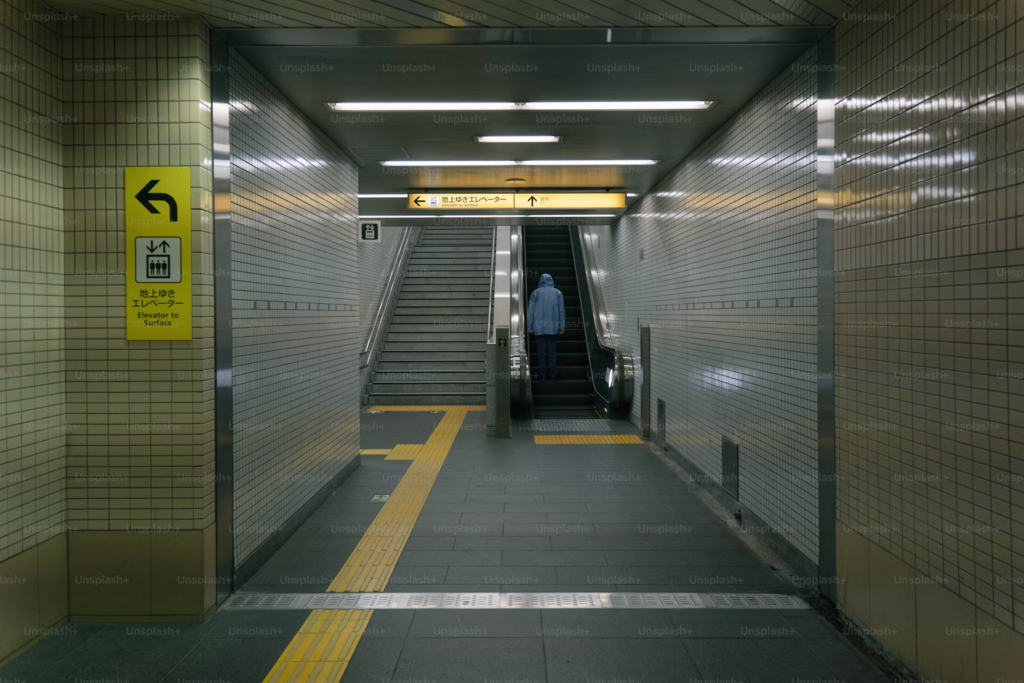
More and more attractions in Kyoto are now accessible, though some historical sites still have stairs or gravel paths.
Top Accessible Spots:
- Kyoto Station & Kyoto Tower (elevators, wide paths)
- Arashiyama Bamboo Grove (flat paths, nearby accessible restrooms)
- Fushimi Inari (first few torii gates only, then stairs begin)
- Kyoto Gyoen National Garden (wide, stroller- and wheelchair-friendly paths)
Transportation Tips:
- Buses often lower for wheelchair entry, and priority seats are available
- Trains have elevators and tactile paths for the visually impaired
- JR and subway stations often have barrier-free maps—ask staff for help
🧳 Rental services for:
- Wheelchairs, canes, portable oxygen, and even electric scooters
→ Search for “Kyoto mobility aid rental” or ask your hotel for assistance
🛡️ 5. Travel Insurance: Don’t Skip It
Medical care in Japan is high-quality but can be expensive for visitors. Be sure to:
- Purchase travel insurance with medical and emergency coverage
- Save digital and printed copies of your policy
- Know the local hospital process (you may need to pay first and claim later)
📱 6. Helpful Apps for Safety & Translation
| App | Use |
|---|---|
| Google Translate | For symptoms, directions, and ingredient lists |
| Japan Travel by NAVITIME | Wheelchair-friendly route planning |
| Safety Tips (Japan Tourism Agency) | Natural disaster alerts in English |
| LINE | Useful for contacting locals or requesting help via text |
✍️ 7. Useful Japanese Phrases for Health & Safety
| English | Japanese |
|---|---|
| I need help. | 助けてください (Tasukete kudasai) |
| I feel sick. | 気分が悪いです (Kibun ga warui desu) |
| Is there an English-speaking doctor? | 英語を話せる医者はいますか?(Eigo o hanaseru isha wa imasu ka?) |
| Where is the pharmacy? | 薬局はどこですか?(Yakkyoku wa doko desu ka?) |
🌟 In Summary: A Safe & Supportive Journey
Traveling with older adults or young children doesn’t have to be stressful, especially in Kyoto, where modern healthcare, public safety, and a growing culture of accessibility make multi-generational travel feel secure and supported. With a few preparations, you can explore the city knowing that help, comfort, and care are never far away.
Chapter 13: Packing & Preparation Tips for Kyoto with Kids and Seniors
Smart packing can make your Kyoto trip smooth, stress-free, and enjoyable for everyone, from toddlers to grandparents. In this chapter, we’ll walk you through what to bring, how to prepare, and useful extras that will help your multi-generational travel run like clockwork.
🧳 1. Essential Documents to Carry

Make sure each traveler—especially children and seniors—has:
- Passport (with at least 6 months’ validity)
- Photocopies of ID and travel insurance (keep both physical and digital)
- Hotel booking confirmations
- List of emergency contacts (home and local)
- Medical records or prescriptions (especially for seniors or children with health needs)
- IC card (like ICOCA) for easy travel on buses and trains
💡 Tip: Carry these in a waterproof folder or organizer for easy access at airports and hotels.
🧥 2. Weather-Wise Clothing
Kyoto’s weather changes with the seasons, so pack accordingly:
| Season | Clothing Suggestions |
|---|---|
| Spring (Mar–May) | Light jacket, layers, umbrella |
| Summer (Jun–Aug) | Breathable clothes, sunhat, portable fan, sunscreen |
| Autumn (Sep–Nov) | Sweater or light coat, layers for changing temps |
| Winter (Dec–Feb) | Warm coat, heat packs, scarf, gloves, thermal innerwear |
For seniors, consider non-slip walking shoes and lightweight rain gear. For kids, pack extra socks and a waterproof jacket for surprise showers.
🍼 3. Packing for Kids
Whether you have a toddler or young child, here are kid-specific essentials:
- Diapers/pull-ups (some sizes can be hard to find in Japan)
- Snacks your child likes (especially picky eaters)
- Travel stroller (compact and foldable for buses/trains)
- Baby carrier for temples or crowded areas
- Toys, coloring books, or iPads for long waits
- Sippy cups and utensils (many restaurants may not provide child-specific ones)
- A child ID card with your contact details in Japanese and English
👴 4. Packing for Seniors

Seniors may need a few extra items to stay comfortable:
- Prescription medications (with enough supply for the entire trip)
- Compression socks for flights or long walks
- Walking stick or foldable cane (if needed)
- Reading glasses and a spare pair
- Portable cushion for sitting during long temple visits
- Daily medication organizer
- Lightweight, supportive footwear
💡 If mobility is an issue, consider booking a wheelchair rental in advance.
⚕️ 5. First-Aid & Medical Kit

Prepare a basic health kit for your group:
- Band-aids, antiseptic cream
- Insect repellent (especially in summer)
- Fever and pain relievers (children’s and adults’)
- Motion sickness meds (for trains, buses)
- Thermometer
- Personal prescription medicines
- Cold patches or heat packs
Keep this in your day bag for easy access during outings.
🧼 6. Hygiene & Personal Care
While Japan is very clean, it’s good to bring:
- Wet wipes / antibacterial hand gel
- Travel-sized toiletries (soap, shampoo, lotion)
- Tissues (some public toilets don’t provide toilet paper)
- Travel towels (for onsen visits or drying hands)
Pro Tip: Most convenience stores in Kyoto stock hygiene products, but it helps to come prepared for your first few days.
📱 7. Helpful Tech Tools to Pack
- Portable Wi-Fi or SIM card for maps and translation
- Universal power adapter (Japan uses Type A plugs, 100V)
- Extra power banks for phones and tablets
- Noise-canceling headphones (great for kids on long flights)
- Tablet or e-reader with movies/books downloaded
- Translation app (Google Translate) pre-installed
👜 8. Daypack Checklist for Family Outings
Here’s a quick list of what to carry during daily sightseeing:
✔ Passports & hotel contact card
✔ Water bottles
✔ Snacks for kids and seniors
✔ Travel tissues & wipes
✔ Umbrella or sunhat (seasonal)
✔ First-aid kit
✔ Extra clothes for kids
✔ Power bank
✔ IC cards & cash
✔ Maps (paper or digital backup)
💡 Use a backpack or cross-body bag for easy access and hands-free movement.
🧘 9. Mental Preparation: Set the Right Pace
A key part of preparation is planning the right mindset:
- Schedule rest periods during the day
- Choose 1–2 major sights per day, not more
- Let older adults and children set the walking pace
- Book accommodations with breakfast to start the day with ease
- Plan for indoor activities in case of rain or fatigue
🌟 In Summary: Thoughtful Packing = Happy Traveling
Kyoto is welcoming, but being well-prepared ensures your family—young or old—enjoys every moment. From smart clothing choices to child- and senior-specific items, thoughtful packing turns a good trip into a great one.
Now that you’re packed and ready, you’re just about set for a magical journey through Kyoto.
Chapter 14: Family-Friendly Japanese Words & Etiquette Tips
A few polite words and a little cultural awareness go a long way in Japan, especially in a traditional city like Kyoto. Whether you’re traveling with young children or older adults, this guide helps your entire family connect respectfully with locals and navigate daily situations with ease.
🗣️ 1. Easy Japanese Phrases for Families
You don’t need to be fluent! Just knowing a few simple and polite Japanese expressions can create warm moments and earn smiles.
| English | Japanese | Pronunciation |
|---|---|---|
| Hello | こんにちは | Konnichiwa |
| Thank you | ありがとう | Arigatou |
| Thank you very much | ありがとうございます | Arigatou gozaimasu |
| Excuse me / Sorry | すみません | Sumimasen |
| Please | おねがいします | Onegaishimasu |
| Yes / No | はい / いいえ | Hai / Iie |
| Do you have…? | ありますか? | Arimasu ka? |
| Where is the toilet? | トイレはどこですか? | Toire wa doko desu ka? |
| I don’t understand | わかりません | Wakarimasen |
| I can’t speak Japanese | 日本語が話せません | Nihongo ga hanasemasen |
| Help! | たすけて! | Tasukete! |
💡 Tip: Teach children simple words like “arigatou” to use after meals or when someone helps them—locals love seeing kids try!
👏 2. Basic Etiquette Tips for Families & Seniors
Japanese culture values politeness, calm behavior, and cleanliness. Here are key etiquette rules that your family should follow:
🚆 On Trains & Buses
- Speak quietly or not at all—phones should be on silent.
- Priority seats are for pregnant women, the elderly, people with disabilities, and parents with small kids, but anyone can sit there if not occupied.
- Fold strollers if the train is crowded.
🍽️ At Restaurants
- Say “Itadakimasu” before eating and “Gochisousama deshita” after your meal.
- Don’t stick chopsticks upright in rice—this is associated with funerals.
- Slurping noodles is okay and even shows appreciation!
- Many restaurants have plastic food displays outside—use them to order if needed.
🏯 At Temples & Shrines
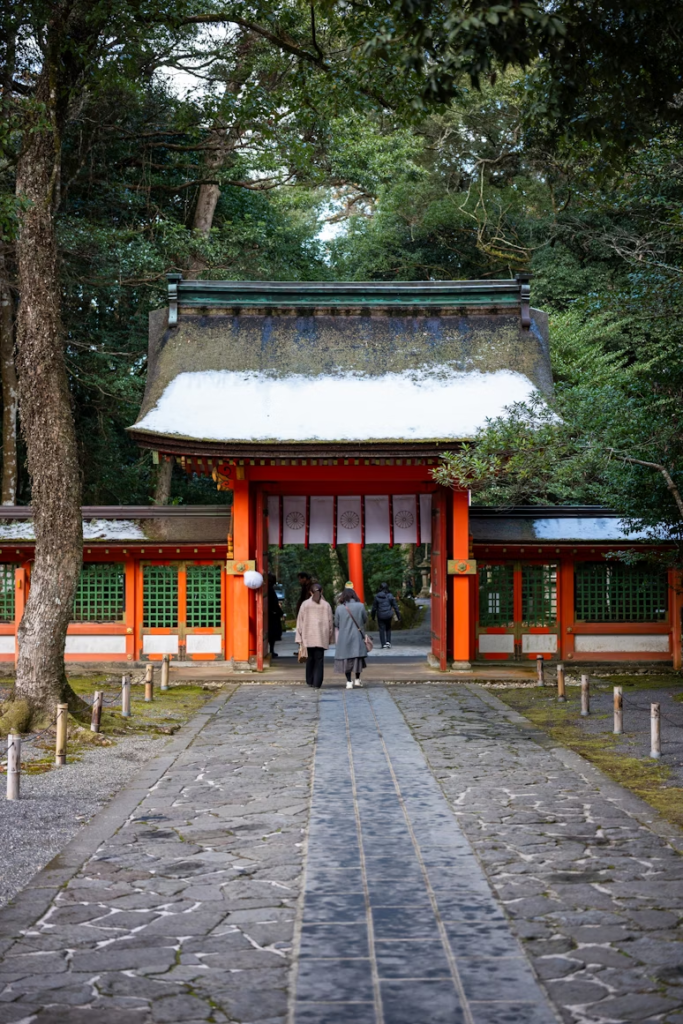
- Be quiet and respectful—no loud talking or running.
- Clean your hands and mouth at the purification fountain near the entrance.
- Do not enter sacred areas that are roped off or marked private.
- Don’t touch statues or artifacts unless signage says it’s okay.
🎎 In Public
- Avoid eating or drinking while walking.
- Do not point fingers—gesture with an open hand.
- Take your trash with you—public bins are rare.
- Remove shoes when entering tatami rooms, some traditional inns, or temples.
🚼 3. Family-Friendly Cultural Considerations
- Japanese people are generally very kind to children and respectful of elders. Don’t be surprised if locals offer your child a smile or a small gift.
- Kyoto is more conservative than big cities like Tokyo, so modest dress is appreciated at temples and historic sites.
- For seniors: Don’t hesitate to accept help from locals—they’ll often offer assistance without being asked.
- For kids: Help them practice bowing slightly as a greeting—it’s fun and shows good manners!
📱 4. Useful Apps for Communication & Translation
Download these free apps before your trip:
- Google Translate: Instant translation by typing, voice, or camera scan
- VoiceTra: Japan’s government-supported translation app (great for seniors)
- Imiwa? or Yomiwa: For reading Japanese characters and learning vocabulary
- Google Lens: Use your camera to translate menus, signs, and packaging
💡 Download offline language packs in case there’s no Wi-Fi.
🎒 5. Teaching Kids & Seniors About Local Manners Before You Go
To make travel smoother, talk to your group about:
- Using indoor voices in public
- Waiting in line patiently (common in Japan)
- Handling money with both hands when paying
- Removing hats and sunglasses inside temples
- Practicing simple bowing and thank-yous
💡 Turn it into a fun “Japan manners challenge” for kids with rewards for good behavior!
🌟 In Summary: Polite Words, Big Smiles
You don’t need to master Japanese or memorize every custom—just a few kind words and respectful behavior can make your Kyoto trip even more meaningful. Locals appreciate effort, and your family’s willingness to connect will be met with warmth and hospitality.
Chapter 15: Using Public Baths with Children or Elders

Public baths, or “sento” and hot spring baths (“onsen”), are a beloved part of Japanese culture and a soothing experience for all ages, especially after a day of sightseeing. If you’re traveling with young children or older adults, Kyoto’s public baths can become a memorable, relaxing family tradition. Here’s how to enjoy them respectfully and comfortably.
♨️ What to Expect at a Japanese Bathhouse
Japanese baths are about soaking, not washing—cleanliness is expected before entering the shared tub. Here’s the typical order of events:
- Pay at the front desk (some small sento accept cash only).
- Separate entrances for men and women (look for color-coded curtains: red for women, blue for men).
- Undress completely in the locker area—swimwear is not allowed.
- Enter the bathing area and wash thoroughly at the shower stations.
- Once clean, soak and relax in the shared hot bath.
👵 Tips for Older Adults
- Choose baths with grab rails or accessible tubs—many modern onsen have senior-friendly features.
- Avoid very hot baths (some reach over 42°C) if you have heart or blood pressure concerns.
- Bring water to stay hydrated, and take breaks between soaks.
- Mid-mornings and early afternoons are less crowded and quieter.
👶 Tips for Families with Young Children
- Many baths allow children of either gender to accompany a parent up to around age 6–8, depending on the facility.
- Teach kids to:
- Wash before entering the tub
- Avoid splashing or loud talking
- Respect other bathers’ personal space
- Bring small bath toys or washcloths for comfort, but keep them discreet and quiet.
- Choose smaller, family-friendly baths or hotels with private onsen rooms for more flexibility.
🎒 What to Bring
- Towel (some baths provide them, some charge a rental fee)
- Toiletries (many offer basics, but it’s good to bring your own)
- A change of clothes
- Coins or small bills for entry (typically ¥400–¥800 per person)
💡 Bonus: Private Baths (Kashikiri Onsen)
If your family feels shy about bathing in public, consider booking a private onsen—many ryokan (traditional inns) and hotels offer them for families or couples. These are perfect for:
- Mixed-gender families
- Modest travelers
- Elderly guests who need assistance
🌸 In Summary
Bathing together is more than hygiene in Japan—it’s a shared ritual of relaxation and connection. With a little cultural understanding and preparation, visiting a sento or onsen can be a highlight of your Kyoto journey, bringing generations together in warm water, calm minds, and peaceful hearts.
Chapter 16: Conclusion – Creating Cherished Memories in Kyoto for All Generations
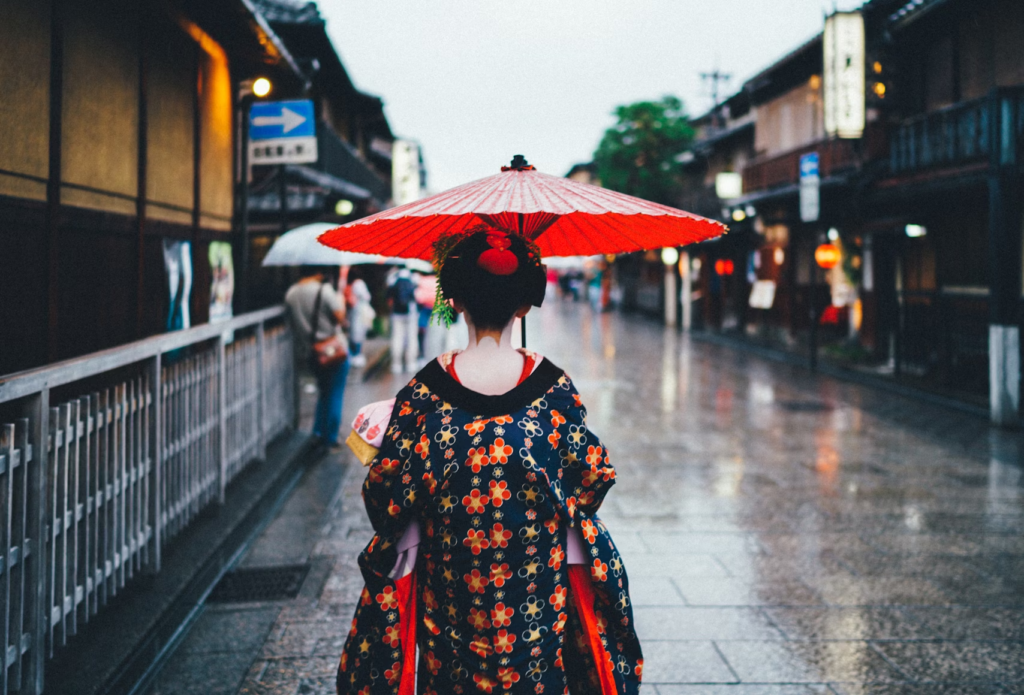
Travel isn’t just about seeing new places—it’s about bonding, discovering, and creating unforgettable moments with the people you love. In Kyoto, that magic becomes real. Whether you’re watching a grandparent smile during a quiet tea ceremony, seeing your children laugh while feeding deer in a temple garden, or enjoying a peaceful walk through bamboo groves as a family, Kyoto offers something truly special for every generation.
👨👩👧👦 A City That Connects Generations
Kyoto is one of the rare places where children, parents, and grandparents can all enjoy the same destination, in different ways—but together. The city welcomes you to explore at your own pace, discover cultural wonders, and embrace the simplicity of shared experiences.
- For seniors: Peaceful gardens, gentle sightseeing, and traditional wellness experiences await.
- For children: Hands-on fun, colorful history, and friendly faces bring Japan to life.
- For everyone: Kyoto brings families closer together in ways few cities can.
🗺️ Well-Planned = Stress-Free Travel
From choosing the best season and booking the right accommodation to knowing what to pack and how to communicate, planning a multi-generational trip may seem like a big task, but with the right guidance, it becomes a joyful process.
This guide has shown you:
- When and how to travel comfortably in Kyoto
- What to see and do for every age
- Where to eat, sleep, and relax
- How to get around easily and safely
- How to respect local customs and connect with kindness
🎎 Kyoto Is More Than a Destination—It’s a Memory Maker
In the end, what makes Kyoto unforgettable isn’t just the UNESCO temples, the geisha sightings, or the cherry blossoms. It’s the little things:
- A shared bento lunch by the river
- A warm bath after a long day of exploring
- A photo in a kimono that becomes a family treasure
- A smile from a local when your child says “Arigatou”
Kyoto gives families and seniors not just places to visit, but moments to remember.
✈️ Ready to Go?
Kyoto is waiting for you—with its ancient traditions, peaceful streets, and family-friendly charm. Whether it’s your first visit or a long-awaited return, one thing’s certain: You’ll leave with more than souvenirs—you’ll leave with stories.
So start planning. Pack your bags. Bring the generations together.
Kyoto Made Easy. Memories Made Forever.
Klook.comDisclosure: This post contains affiliate links. If you buy something through them, I will receive a small commission at no additional cost to you. Thank you for your support.
















